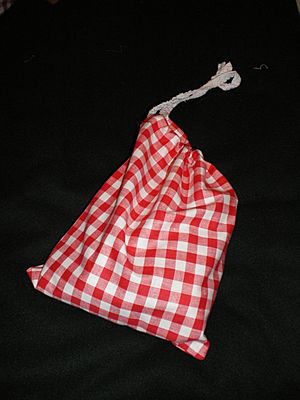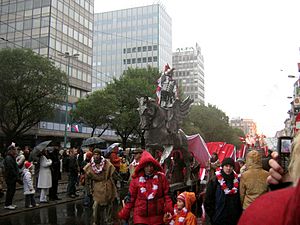St. Martin's Day facts for kids
Saint Martin's Day, also known as the Feast of Saint Martin or Martinmas, is a special day celebrated on November 11th each year. It honors Saint Martin of Tours, a kind and brave Roman soldier who later became a bishop. This day was traditionally a time for big feasts, especially with goose, and marked the end of the autumn harvest season. It was also a time when farm workers might look for new jobs.
Saint Martin of Tours was a Roman soldier who chose to become a Christian and later a bishop in France. One famous story tells how he cut his warm cloak in half during a snowstorm to share it with a freezing beggar. That night, he dreamed of Jesus wearing the half-cloak, saying, "Here is Martin, the Roman soldier who is now baptized; he has clothed me." Saint Martin passed away on November 8, 397, and was buried three days later.
Customs and Traditions
Feasting and Fun
This holiday started in France and then spread across Europe, including places like Germany, the British Isles, and Scandinavia. Martinmas is a day to remember Saint Martin during a special church service. It's also a big celebration for the end of the farming year and the main harvest. Saint Martin was known for being a friend to children and helping those in need.
The day marks the start of winter in the old farming calendar. It's also when freshly made beer and wine are ready to drink. People used to prepare for winter by butchering animals, which is why eating goose became a tradition. It's a bit like Thanksgiving in America, celebrating all the good things the earth provides. Since it comes before a time of quiet reflection (Advent), it also became a mini-carnival with feasts, dancing, and bonfires.
In some places, Martinmas celebrations begin at 11:11 AM on November 11th. In others, the fun starts on the evening of November 10th. People light bonfires, and children carry lanterns through the streets, singing songs. They often get candy as a reward!
Why Geese?
The goose became a symbol of Saint Martin because of a funny story. Legend says that when he tried to avoid becoming a bishop, he hid in a goose pen. But the noisy geese started cackling, giving away his hiding spot! Eating goose on this day became a popular custom, especially in towns. If people couldn't afford goose, they might eat duck or chicken instead.
Grapes and Wine
Even though early stories about Saint Martin don't mention it, he is often given credit in France for helping to spread wine-making in the Tours region. He's even said to have introduced a special type of grape called Chenin blanc, which is used for many white wines.
Celebrations Around the World
Austria
In Austria, Martinloben is a big festival with art, wine tasting, and live music. Martinigansl (roasted goose) is the traditional meal. Children walk in parades with lanterns they made at school, singing Martin songs.
Belgium
On the evening of November 10th, children in some parts of Belgium carry paper lanterns and candles, singing songs about Saint Martin. Sometimes, a person dressed as Saint Martin rides a horse at the front of the parade. In some areas, children receive gifts from Saint Martin on November 11th. In Wervik, children go door-to-door with hollow beetroots carved with faces and candles inside, singing songs. Later, they throw the beetroots into a bonfire and eat pancakes.
Croatia
In Croatia, Saint Martin's Day (Martinje) is when new grape juice traditionally turns into wine. People dress up as a bishop to "baptize" the wine. The traditional foods are goose and a type of pasta called mlinci.
Hungary
In Hungary, people used to have big feasts and parties on this day, believing it would bring plenty of food for the next year. A common saying is: "He who does not eat a goose on Martin's day will starve all year round." Goose dishes, like roast goose with red cabbage, are popular. People also watch the weather: "On St. Martin's Day, if the goose walks on ice, it will toddle in water at Christmas." This means if it's freezing on Martin's Day, Christmas might not have snow.
Czech Republic
A Czech saying about Saint Martin's Day is: "Martin is coming on a white horse," meaning it often starts to snow in early November. Restaurants serve roast goose and a special young wine called Svatomartinské víno, which is the first wine of the season. Many places pour the first wines at 11:11 AM.
Denmark
In Denmark, Mortensaften (the evening of Saint Martin) is celebrated with traditional dinners, often featuring duck instead of goose because it's smaller or cheaper.
Estonia
In Estonia, Mardipäev mixes old European customs with local traditions. It marks the end of the farming year and the start of winter. Children dress up and go door-to-door, singing songs and telling jokes to get sweets.
France
Saint Martin's Day is celebrated in parts of France, like Alsace. Children receive gifts and candies. In Alsace, families make colorful paper lanterns and carry them in parades up mountains at night. This day marks the start of the holiday season in these regions.
Germany

A common tradition in Germany is Martinsfeuer (bonfires) on Saint Martin's Eve. Children walk in parades with lanterns they made, singing Martin songs. A person dressed as Saint Martin often rides a horse with them. When they reach the square, the bonfire is lit, and special pretzels are given out. In some areas, children also go house-to-house with their lanterns, singing for candy.
The lantern parades might have started as a way to represent the light of holiness, just as Saint Martin brought hope to the poor. The traditional meal is Martinsgans (Saint Martin's goose), served roasted with red cabbage and dumplings. Another sweet treat is Martinshörnchen, a croissant-shaped pastry that looks like Saint Martin's horse's hooves or half of a pretzel, symbolizing his shared cloak.
Great Britain
Saint Martin's Day isn't widely celebrated in Great Britain today, as November 11th is also Remembrance Day. However, some churches still hold services for Saint Martin. In Scotland, it's one of the "term days" for schools and universities. "Martlemass beef" used to be cattle slaughtered at this time and preserved for winter. The term "St. Martin's Summer" refers to a brief warm spell around this date, similar to an Indian summer.
In Welsh mythology, Saint Martin's Day was linked to the Cŵn Annwn, ghostly hounds that would hunt for criminals. People believed that if they heard an owl hooting or saw a meteor on this day, it was a bad sign.
Ireland
In some parts of Ireland, people used to sacrifice a cockerel on Saint Martin's Eve and sprinkle its blood on the corners of the house. It was also believed that no wheels should turn on Saint Martin's Day, because some thought Martin was killed by a mill wheel. A local story in Co. Wexford says that going to sea on this day is dangerous because Saint Martin rides a white horse across Wexford Bay, bringing drowning to anyone who sees him.
Italy
Sicily
In Sicily, November is wine-making season. On Saint Martin's Day, Sicilians eat hard biscuits dipped in sweet wines. l'Estate di San Martino (Saint Martin's Summer) is a traditional name for a short period of unusually warm weather in early November.
Latvia
Mārtiņi is celebrated on November 10th in Latvia. It marks the end of winter preparations, like salting meat and storing the harvest. It also signals the start of fun winter activities like sledding.
Malta
Saint Martin's Day (Jum San Martin) is celebrated in Malta on the Sunday closest to November 11th. Children receive a special bag of fruits and sweets called Il-Borża ta' San Martin ("St. Martin's bag"). This bag often has walnuts, hazelnuts, almonds, chestnuts, dried or processed figs, and seasonal fruits like oranges and pomegranates, plus a special bread roll.
There's a traditional rhyme for this custom:
Ġewż, Lewż, Qastan, Tin
Kemm inħobbu lil San Martin.
(Walnuts, Almonds, Chestnuts, Figs
I love Saint Martin so much.)
A feast is held in the village of Baħrija, with a procession and a fair.
Netherlands
On the evening of November 11th, children aged 5 to 12 go door-to-door with handmade lanterns, singing songs to receive candy or fruit. In the past, poor people would visit farms on this day to get food for winter. Saint Martin is the patron saint of Utrecht, where a big lantern parade is held.
Poland
In Poland, Saint Martin's Day (Dzień Świętego Marcina) is celebrated mainly in Poznań. People buy and eat many special croissants filled with almond paste and white poppy seeds, called Rogal świętomarciński. Legend says a baker dreamed of Saint Martin riding a white horse that lost a golden horseshoe. The next morning, the baker made horseshoe-shaped croissants and gave them to the poor. The city organizes concerts, parades, and fireworks on Saint Martin's Street. Goose meat is also eaten.
Portugal
In Portugal, Saint Martin's Day (Dia de São Martinho) is linked to tasting the new wine of the year. People gather around a bonfire, eating roasted chestnuts and drinking água-pé (a light drink made from grape leftovers) or jeropiga (a sweeter, stronger drink).
A common Portuguese saying is:
É dia de São Martinho;
comem-se castanhas, prova-se o vinho.
(It is St. Martin's Day,
we'll eat chestnuts, we'll taste the wine.)
This time of year often has good weather, called Verão de São Martinho (St. Martin's Summer). This is often connected to the legend, where Jesus brings an end to the rain (instead of snow) to give this warm spell.
Sint Maarten / Saint Martin
On the island of Saint Martin, November 11th is a public holiday. It marks the day explorer Christopher Columbus landed on the island in 1493 and named it "Saint Martin."
Slovakia
In Slovakia, this day is a celebration for people named Martin or Martina, who often receive small gifts. Folklore says if it snows on this day, "Saint Martin came on a white horse," meaning it will snow on Christmas Day.
Slovenia
The biggest celebration in Slovenia is in Maribor, marking the end of the wine-growing season. There's a special ceremony for the new wine and a Wine Queen. The main square fills with musicians and stalls selling autumn foods.
Spain
In Spain, Saint Martin's Day is traditionally when pigs are prepared for winter. This led to the saying, "Every pig gets its St Martin," meaning wrongdoers eventually face consequences. Saint Martin is widely celebrated in Galicia.
Sweden
Saint Martin's Day (Mårtensafton) was an important autumn feast in Sweden. Eating goose spread from France, especially in Scania where goose farming is common. A traditional goose dinner also includes svartsoppa (a spiced soup) and apple charlotte.
Switzerland
The celebration is still a tradition in the Ajoie region of Switzerland. The Repas du Saint Martin is a huge feast with many parts of freshly prepared pigs, lasting for hours.
United States
Saint Martin's Day isn't widely celebrated in the United States, but some communities with European heritage hold events. German restaurants might offer traditional goose and mulled wine. In St. Paul, Minnesota, there's a lantern procession. In Dayton, Ohio, a German organization hosts a family celebration with a lantern parade and bonfire. Phoenix, Arizona, also has an annual German lantern procession.
In Art
Pieter Bruegel the Elder's largest painting is The Wine of Saint Martin's Day, which shows the saint helping others. There's a similar painting by Peeter Baltens that can be seen here.
See also
 In Spanish: Fiesta de San Martín para niños
In Spanish: Fiesta de San Martín para niños




